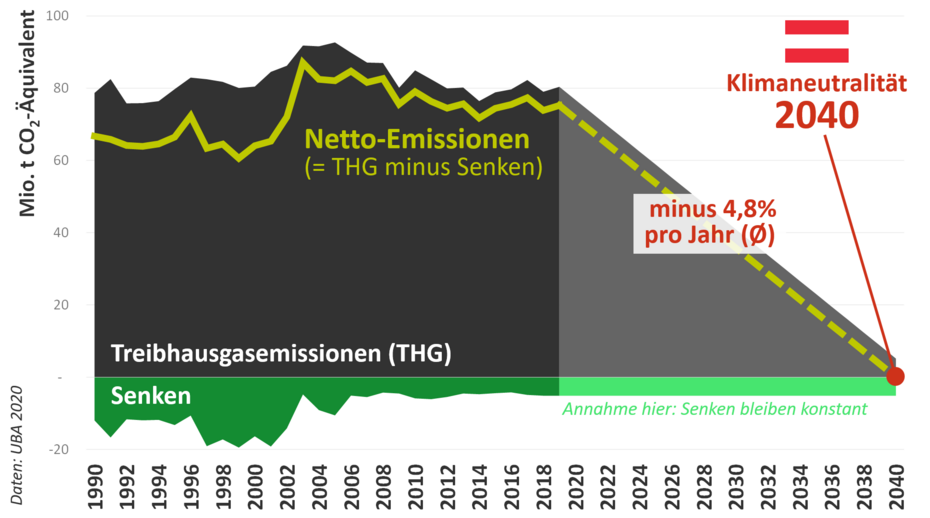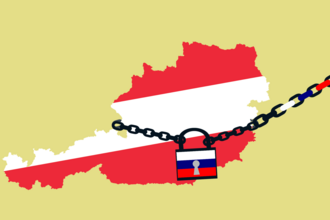
A Political Frame
Creating the political framework for climate neutrality
In order to effectively minimize the serious effects of the climate crisis, greenhouse gas emissions must be drastically and rapidly reduced. The central guideline for this project is the Paris Climate Agreement, which stipulates limiting the increase in the global average temperature to well below 2°C above pre-industrial levels, if possible to 1.5°C.
The European Union wants to become climate-neutral by 2050, while the Austrian federal government has set itself the goal of achieving climate neutrality by 2040. Climate neutrality means that there is a balance between sources and sinks for greenhouse gas emissions, with net emissions at zero ("net zero").
On a linear reduction path, Austria's net emissions would have to be reduced by an average of 4.8% per year in order to achieve greenhouse gas neutrality by 2040. (simplified illustration that does not take into account a "Paris-compatible" CO2 budget, as envisaged in the government agreement)

A political framework sets the course for the missionzero, the path to climate neutrality
The commitment to the Paris Climate Agreement and the climate targets derived from it requires decisive action at various levels of governance: international climate diplomacy is necessary to ensure global progress. The European Green Deal and associated directives, regulations and acts are formative for the member states and dominate the political and legal scope at national level. In addition to the federal government, the municipalities, federal states and associated authorities also play a key role in shaping the political framework for achieving climate neutrality.
The range of possible policy instruments is broad. Many experts consider the pricing of greenhouse gas emissions (e.g. emissions trading system, taxes, carbon border adjustment) to be an economically effective measure for triggering climate-friendly behavior. Regulatory measures (e.g. bans, standards, quotas) are also effective instruments. To support new technologies in penetrating the market, subsidies and other measures are necessary (e.g. market premiums, grants, innovation support, special regulatory zones, financing of demonstration projects). In addition, information and awareness-raising as well as ensuring an enabling environment (e.g. education and training, availability of skilled workers and human resources in administration) are an indispensable part of energy and climate policy.
We provide answers for a climate-neutral future
The analysis and evidence-based design of political framework conditions has been an important focus of our activities since the Austrian Energy Agency was founded in 1977. We develop the basis for climate and energy strategies (e.g. National Energy and Climate Plan, Salzburg Master Plan) and analyze and provide facts for laws and funding programs. We also play a coordinating and moderating role in shaping energy and climate policy frameworks (e.g. Concerted Action on the EU Renewable Energy Directive) and implementing awareness-raising initiatives (e.g. klimaaktiv).
With this in mind, we not only advise politicians and administrations, but also companies and their representatives on the monitoring or implementation of policy measures (e.g. Energy Efficiency Act).We are characterized by our expertise on current developments in EU, federal and state policy and a holistic, independent perspective that allows us to classify developments based on facts and independently of individual interests.
Contact person






![[Translate to English:] Logo des Projektes Ensmov plus](/fileadmin/_processed_/f/c/csm_ensmov-plus_logo_kachel_7b66841a6b.jpg)
